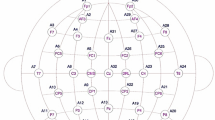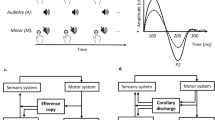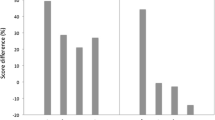Summary
In a duration-discrimination experiment, young adults (mean age = 25.1), middle-aged adults (mean age = 45.5), and older adults (mean age = 64.6) were presented with two very brief auditorily marked intervals per trial, and their task was to decide which of the two was longer in duration. An adaptive psychophysical procedure was used to determine difference thresholds in relation to a constant standard interval of 50 ms. It was found that duration-discrimination performance was unaffected by age; all three age groups yielded a difference threshold of approximately 17 ms. It was concluded that the ability to discriminate durations of very brief auditory intervals appears to be based on an underlying timing mechanism that does not slow down with advancing adult age.
Similar content being viewed by others
References
Block, R. A. (1990). Models of psychological time. In R. A. Block (Ed.), Cognitive models of psychological time (pp. 1–35). Hillsdale, NJ: Erlbaum.
Church, R. M. (1984). Properties of the internal clock. In J. Gibbon & L. G. Allan (Eds.), Timing and time perception (pp. 566–582). New York: New York Academy of Sciences.
Cranford, J. L., & Stream, R. W. (1991). Discrimination of short duration tones by elderly subjects. Journal of Gerontology: Psychological Sciences, 46, P37–41.
Creelman, C. D. (1962). Human discrimination of auditory duration. Journal of the Acoustical Society of America, 34, 582–593.
Cronbach, L. J. (1990). Essentials of psychological testing. New York: Harper and Row.
Feifel, H. (1957). Judgment of time in younger and older persons. Journal of Gerontology, 12, 71–74.
Florentine, M., & Buns, S. (1984). Temporal gap detection in sensorineural and simulated hearing impairments. Journal of Speech and Hearing Research, 27, 449–455.
Gengel, R. W. (1973). Temporal effects in frequency discrimination by hearing-impaired listeners. Journal of the Acoustical Society of America, 54, 11–15.
Goldstone, S., Boardman, W. K., & Lhamon, W. T. (1958). Kinesthetic clues in the development of time concepts. Journal of Genetic Psychology, 93, 185–190.
Ison, J. R., O'Connor, K., Bowen, G. P., & Bocimea, A. (1991). Temporal resolution of gaps in noise by the rat is lost with functional decortication. Behavioral Neuroscience, 105, 33–40.
James, W. (1899). The principles of psychology, Vol. 1. New York: Holt.
Joubert, C. E. (1983). Subjective acceleration of time: Death anxiety and sex differences. Perceptual and Motor Skills, 57, 49–50.
Joubert, C. E. (1984). Structured time and subjective acceleration of time. Perceptual and Motor Skills, 59, 335–336.
Kausler, D. H. (1982). Experimental psychology and human aging. New York: Wiley.
Keele, S. W. (1987). Sequencing and timing in skilled perception and action: An overview. In A. Allport, D. G. MacKay, W. Prinz, & E. Scheerer (Eds.), Language perception and production: Relationships between listening, speaking, reading, and writing (pp. 463–487). London: Academic Press.
Keele, S. W., Pokomy, R. A., Corcos, D. M., & Ivry, R. (1985). Do perception and motor production share common timing mecha-nisms? A correlational analysis. Acta Psychologica, 60, 173–191.
Klapp, S. T. (1981). Temporal compatibility in dual motor tasks II: Simultaneous articulation and hand movements. Memory & Cognition, 9, 398–401.
LeBlanc, A. P. (1969). Time orientation and time estimation: a function of age. Journal of Genetic Psychology, 115, 187–194.
Leibowitz, H., & Gwozdecki, J. (1967). The magnitude of the Poggendorff illusion as a function of age. Child Development, 38, 573–580.
Leibowitz, H., & Judisch, J. M. (1967). Size constancy in older persons: A function of distance. American Journal of Psychology, 80, 294–296.
Lemlich, R. (1975). Subjective acceleration of time with aging. Perceptual and Motor Skills, 41, 235–238.
Levitt, H. (1971). Transformed up-down methods in psychoacoustics. Journal of the Acoustical Society of America, 49, 467–477.
Lima, S. D., Hale, S., & Myerson, J. (1991). How general is general slowing? Evidence from the lexical domain. Psychology and Aging, 6, 416–425.
Lisker, L., & Abramson, A. S. (1967). Some effects of context on voice onset time in English stops. Language and Speech, 10, 1–28.
McCroskey, R. L. (1979). Some characteristics of temporal auditory behavior among elderly persons. In M. A. Henoch (Ed.), Aural rehabilitation for the elderly (pp. 149–167). New York: Grune and Stratton.
McCroskey, R. L. (1984). Wichita auditory fusion test. Tulsa, OK: Modern Education Corporation.
McCroskey, R. L., & Kasten, R. N. (1980). Assessment of central auditory processing. In R. R. Rupp & K. G. Stockdell (Eds.), Speech protocols in audiology (pp. 339–389). New York: Grune and Stratton.
Michon, J. A. (1985). The compleat time experiencer. In J. A. Michon & J. L. Jackson (Eds.), Time, mind, and behavior (pp. 21–52). Berlin: Springer.
Peters, M. (1977). Simultaneous performance of two motor activities: The factor of timing. Neuropsychologia, 15, 461–465.
Prinz, W. (1987). Ideo-motor action. In H. Heuer & A. F. Sanders (Eds.), Perspectives on perception and action (pp. 47–76). Hillsdale, NJ: Erlbaum.
Rammsayer, T. (1989 a). Dopaminergic and serotoninergic influence on duration discrimination and vigilance. Pharmacopsychiatry, 22, Suppl., 39–43.
Rammsayer, T. (1989 b). Is there a common dopaminergic basis of time perception and reaction time? Neuropsychobiology, 21, 37–42.
Rammsayer, T. (1990). Temporal discrimination in schizophrenic and affective disorders: evidence for a dopamine-dependent internal clock. International Journal of Neuroscience, 53, 111–120.
Rammsayer, T. H. (1992). Die Wahrnehmung kurzer Zeitdauern. [Perception of brief time intervals]. Munster, - New York: Waxmann.
Rammsayer, T. H., & Lima, S. D. (1991). Duration discrimination of filled and empty auditory intervals: Cognitive and perceptual factors. Perception & Psychophysics, 50, 565–574.
Robin, D. A., & Royer, F. L. (1989). Age-related changes in auditory temporal processing. Psychology and Aging, 4, 144–149.
Salthouse, T. A. (1985). Speed of behavior and its implications for cognition. In J. E. Birren, & K. W. Schaie (Eds.), Handbook of the psychology of aging (pp. 400–426). New York: Van Nostrand Reinhold.
Salthouse, T. A., Wright, R., & Ellis, C. L. (1979). Adult age and the rate of an internal clock. Journal of Gerontology, 34, 53–57.
Sturr, J. F., Church, K. L., & Taub, H. A. (1988). Temporal summation functions for detection of sine-wave gratings in young and older adults. Vision Research, 28, 1247–1253.
Surwillo, W. W. (1964). Age and the perception of short intervals of time. Journal of Gerontology, 19, 322–324.
Treisman, M. (1963). Temporal discrimination and the indifference interval: Implication for a model of the “internal clock.” Psychological Monographs, 77, 1–31.
Treisman, M., Faulkner, A., Naish, P. L. N., & Brogan, D. (1990). The internal clock: Evidence for a temporal oscillator underlying time perception with some estimates of its characteristic frequency. Perception, 19, 705–743.
Walker, J. (1977). Time estimation and total subjective time. Perceptual and Motor Skills, 44, 527–532.
Author information
Authors and Affiliations
Rights and permissions
About this article
Cite this article
Rammsayer, T.H., Lima, S.D. & Vogel, W.H. Aging and temporal discrimination of brief auditory intervals. Psychol. Res 55, 15–19 (1993). https://doi.org/10.1007/BF00419889
Received:
Accepted:
Issue Date:
DOI: https://doi.org/10.1007/BF00419889




